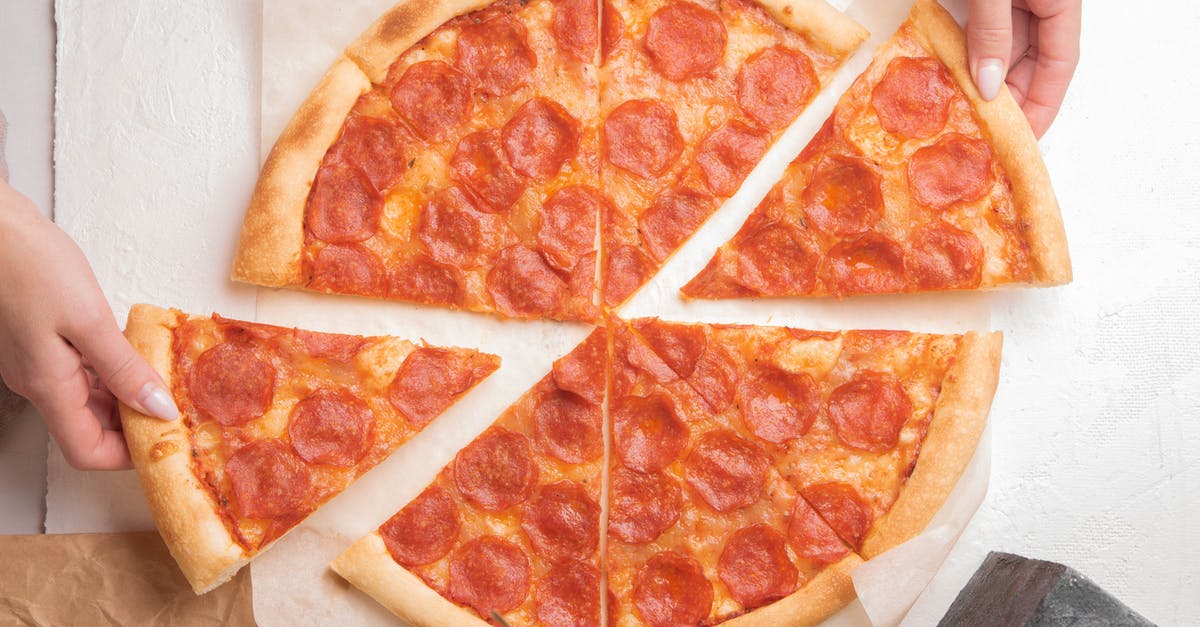How to avoid getting the pizza all watery?

When I cook pizza, it gets all watery. There's literally water formed on top of the dough. I believe it's released by the mozzarella, but I'm not totally sure.
Any ideas how to avoid this?
Some more information: I'm cooking at around 230 oC (according to the oven, who knows!) with an electric oven. No stone, just the metal tray. The pizza has exactly the same shape as the metal tray (which is a rectangle, just as the oven).
According to my last experiments, the source of the water is definitely the cheese. I'm cooking the dough, then adding the tomato sauce, then adding the cheese and the water doesn't appear until the cheese-phase. I tried all the possible mozzarellas that I can get at the supermarket with the same result.
Best Answer
There are a number of factors that can contribute to a watery pizza:
- Cheese If you think the cheese is the culprit, you can try using a "low moisture" mozzarella (these are dry to the touch on the outside). If you are using a "fresh" mozzarella (these usually are sold in a brine), e.g., classic mozzarella di bufala or mozzarella fior di latte, I recommend slicing the cheese as opposed to grating the cheese. The idea is that slicing the cheese will produce less surface area, and thereby reduce the amount of water that leeches out. Also, I recommend dabbing the cheese slices with a kitchen towel to remove any surface moisture. If you use this method, it will also help to cut the cheese in very thin slices, since that will release more moisture before it touches the pizza and it will also reduce the amount of cooking time.
- Tomato Sauce I recommend making the sauce yourself. As opposed to simmering the tomatoes/sauce on the stove for a long time, I prefer making a light tomato sauce that actually cooks on the pizza itself. I quickly purée the tomatoes (canned are fine) in a food processor and then let them strain in a fine mesh colander for 30 to 45 minutes, stirring occasionally. That gets rid of a lot of water (the tomatoes lose about half of their volume). Throw in some minced garlic, chopped basil, and season and it is ready to go on the pizza.
- The Cooking Method Since my home oven doesn't get as hot as a traditional pizza oven, I always "blind" cook my pizza without the cheese. In other words, I throw the dough, add the sauce, and then cook it with just the sauce for 4 or 5 minutes. This allows any extra moisture in the sauce to cook off. I then remove the pizza, add the cheese, and then broil it until the cheese is melted and browned.
- The Dough If the dough ends up becoming soggy, you can always compensate by making it a bit thicker.
Pictures about "How to avoid getting the pizza all watery?"



Quick Answer about "How to avoid getting the pizza all watery?"
Basically you have to avoid ingredients with too much water. For instance, if you use mushrooms use them fresh, don't cook then and then add to the pizza. When handling products that use a liquid as preservative (salt water/ vinegar/ oil) drain them with a colander or something similar.How do I make my pizza not watery?
Let's take a deeper dive into what is causing it to be soggy, and how to stop that.Why is my pizza watery in the middle?
The steam from the base can't escape, so it condenses on your crispy surface and turns it wet and soggy. Use a pizza stone or a pan with holes to get a crispy pizza crust. A pizza stone will keep your pizza hot and its porousness will absorb some condensation.How to prevent watering Pizzas, 3 very important tips, with Maestro Massimo Nocerino
More answers regarding how to avoid getting the pizza all watery?
Answer 2
Basically you have to avoid ingredients with too much water. For instance, if you use mushrooms use them fresh, don't cook then and then add to the pizza. When handling products that use a liquid as preservative (salt water/ vinegar/ oil) drain them with a colander or something similar.
However, what's really important is to keep the tomato sauce and fior di latte dry. When it comes to the tomato sauce, mixing the fresh tomato with a tomato paste is helpful. If thickens the tomato sause so you still can use a good amount of those in your pizza, so you don't have to worry about losing any flavor. As a second option you might use less tomato sause, what comes with loss of flavor and moisture, very important for the pizza texture as well.
If you go for a common mozzarella, the yellow one, be aware they'll release lots of oil (usually those products have a high level of fat). Oil plus water in not a good combination on the top of your pizza. There's not much you can do here but use less or find a mozzarella with less/ no fat (again, at flavor loss, as fat is a flavor enhancer).
Fior di latte would be a better choice for a traditional pizza, it's lighter than the mozzarella and has a great flavor. I've seen fior di latte that comes inside buckets with water, what makes them very, very wet, not a good help for you. But there are some hard blocks or shredded fior di latte. Those are a great choice, 'coz they will not make your pizza soggy as they don't release too much water (or any whatsoever).
Cooking from home don't expect much though. As the cook is slow due to the low oven temperature (the ideal temperature starts between 350 and 400 degrees) it slowly dehydrates the toppings, so the water comes out. I work in a wood fire oven and the pizzas are cooked under 6 minutes. At home it takes me 10 to 15 minutes.
Hope it helps.
Cheers!
Rodd
Answer 3
is it water or fat/lipids? It can indeed be the cheese, but many tomatoes also contain high amounts of water. Use harder cheese, and source your tomatoes from elsewhere. Nice, firm, fleshy tomatoes rather than the bloated balls of water typically sold under the name in supermarkets.
Answer 4
I buy the 5 lb. packages of mozzarella from Costco and repackage the cheese in one pizza portions in Ziploc bags and freeze. I noticed that when using the cheese fresh, the pizza was fine but when using the frozen cheese maybe 1 to 3 months later the pizza was very watery (It takes us a long time to use 5 lbs. of cheese). I now spread the frozen cheese out on a large cookie sheet lined with paper towels and let it completely thaw. The paper towels are quite wet after this and have had much drier pizzas.
I also preheat my oven with the stone to 475 to 500 deg. F for 30 mins. and use the "convect roast" setting on my oven. It runs the convection fan at high speed to ensure even cooking and most importantly to me it evaporates as much moisture as possible. I also put the pizza on parchment paper and transfer directly to the pre-heated stone in my oven. It makes a great crisp bottom on the pizza. Plus the paper is never too hot and allows you to pull the pizza into and out of the oven. I used to work at a pizza restaurant.
Tip: I bought a few different sized ceramic floor tiles (thicker than the wall tiles) from Home Depot and pieced them together to make my own pizza stone as many are too small for my liking and this is much cheaper.
Answer 5
The approach I take is to use a cast iron pan at medium-high heat and sprinkle with corn meal and flour. Put dough into pan and in about 2-3 mins (starts to bubble slightly) brush with olive oil.
Then I apply sauce - I thicken a good marinara earlier over low heat. I then use fresh mozzarella that I've sliced and pressed between paper towel sheets to extract water. I've also done a cheese cloth technique. I then add one meat and veg of choice - not too much.
All of this takes another 2-3 mins. I then place the pan in a 550 degree F oven for 10 mins. Occasionally I will add the mozzarella 5 mins into cooking. I then slide the pizza out of the pan, may add some fresh basil, and onto a metal grate to cool prior to slicing.
Low moisture mozzarella and sauce keep things in check and the crust is amazing. I dropped using a stone and even a heavy metal slab for pizza with this approach when the oven can't go above 550 F.
Answer 6
I've come up with a better means of "pre-cooking" the dough, as I've found that the sauce can prevent the dough from getting crisp. Use cheese to prevent the dough from rising in the middle, it allows the crust to rise alone. Just a light amount of mozzarella, mind you, not all of it. Then, after the edges rise and the bottom is slightly cooked, put the sauce on, then the remaining cheese.
I've had tremendous results doing it this way.
Answer 7
I would slice my ingredients thinly eg tomtoes mushrooms and also mozzarella, half bake the dough first as its less likely to soak up the moisture when a little harder. I found the more you put on the pizza the higher the risk of a soggy bottom!!
Answer 8
I make my own tomato paste and I use that directly on the fresh pizza dough. It counteracts any type of moisture and it's tart, sweet flavor adds more dimension to whatever pizza I make. Im sure a store bought paste will work just as well. If using store bought, add a little red chile flake and garlic powder;skip the salt if your cheese and or ingredients are salty. Keeping the the sweetness of the paste is key.
Answer 9
This is a very strange problem so first I would check that your oven's fan isn't blocked and has good air flow.
You could try putting oats or rice in the oven as a desiccant. I have tried it with chips.
I microwave mushrooms as this brings the juice out, and you can drain it off. Drain, or if necessary sieve, all your wet ingredients like tinned tomatoes. Cut out the insides of any whole tomatoes.
Add the cheese just before the pizza is finished cooking, cheese doesn't take long and prevent the lower level breathing.
Unsure of the chemistry but microwaving cheddar and butter causes the fat (I think) to come out of cheese and it leaves you with a spongey dry cheese that may be better suited for you.
Sources: Stack Exchange - This article follows the attribution requirements of Stack Exchange and is licensed under CC BY-SA 3.0.
Images: Kampus Production, SHVETS production, SHVETS production, Nikita Krasnov
